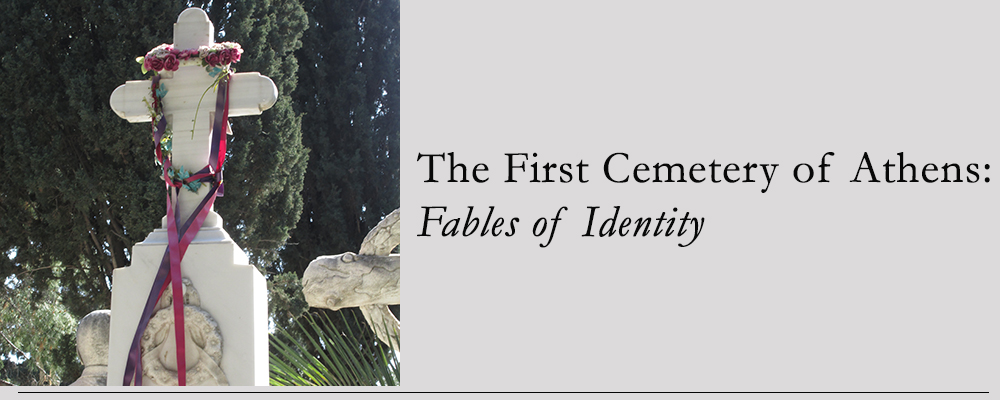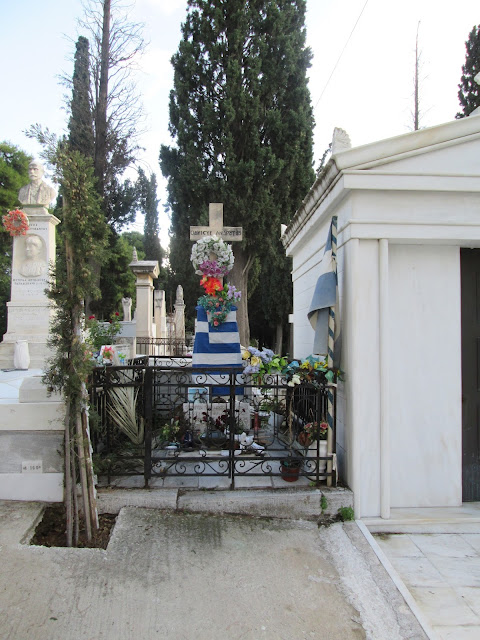Odysseas Androutsos ΟΔΥΣΣΕΑΣ ΑΝΔΡΟΥΤΣΟΣ
Born 1788 or
90 Died June 5, 1825
Section 1,
Number 160
Odysseas
Androutsos started out as a soldier in Ali Pasha’s army in Ioannina, fought
bravely for Greece during the War of Independence, was accused of treason,
murdered by his own people in 1825, and then posthumously rehabilitated. His
life and death highlight the many ambiguities, divided loyalties, and outright
contradictions that characterized the long struggle to create and define the
new nation.
Early life
Odysseas Androutsos, of Albanian extraction, was born in western Greece in Venetian held territory circa 1790. His father, Andreas, had been a legendary figure who had battled the Ottomans until his capture and subsequent death in an Ottoman prison in 1797.Surnames were pretty fluid back then so Odysseas chose Androutsos, his father’s popular nickname, as his own. He had big shoes to fill. According to one source, there are more folk songs about his father than any other klepht or armatolos.(1)
As a young man, Androutsos joined the court of Ali Pasha in Ioannina, and became a successful officer in Ali’s army. At that time Ali Pasha was fighting the Porte, so working for Ali was definitely working against Ottoman interests. A significant number of future Greek freedom fighters would come from the ranks of Ali’s army.
In this strange and rather exotic environment, Androutsos would have learned early on how to navigate in the dangerous waters of divided loyalties and shifting alliances. He was headquartered in Livadia near Delphi from 1816 to 1820. By 1818 he had joined the Filiki Etairia (Φιλική Εταιρεία) which was already plotting the liberation of Greece.
When the revolution broke out in 1821, he distinguished himself at the Battle of Gravia in May 1821.
Omer Vryonis, the commander of the Ottoman army, had first
crushed the Greek resistance near Thermopylae and then, with 8,000 men, headed
south towards the Brallos Pass, intending to pass through, cross the Gulf of
Corinth, and crush the Greek uprising in the Peloponnese before it really got
underway. Androutsos, with a small band,
took up a defensive position at an inn near Gravia and forced Vryonis to delay his
march until reinforcements arrived.
This victory allowed the Greeks to consolidate their
gains in the Peloponnese and capture Tripoli, the Ottoman capital. After this battle, Androutsos was named Commander
in Chief of the Greek forces in eastern Roumeli.(2)
Androutsos resigned his commission as a result of Kolettis’ accusations and in 1823, repaired to a cave on Mount Parnassos where, depending on your point of view, he continued the fight against the Ottomans, co-operated with them, and/or simply hid out beyond the reach of the central government.
Androutsos, dressed to kill...
He had many admirers. John Trelawny, Byron’s friend was an avid Odysseas fan.
Trelawny dressing like his hero
Accounts say that he was then placed in chains and kept in the Frankish tower at the Acropolis entrance. Then, on June 5, 1825, before his trial could be held, he was murdered, – beaten, strangled, and thrown off the acropolis walls.(3) His jailors claimed that his injuries were caused as he tried to ‘escape’. He was quickly and unceremoniously buried by the Church of the Metamorphosis (a Byzantine gem in the north slope of the acropolis which is still there).
Buried, but not forgotten…
His Legacy
If there were a
stock market of Greek heroes, Androutsos stock would have been at rock bottom in 1825. George Finlay, the historian, who had himself lived through the revolution, knew
Androutsos and considered that he, along with all klephts and armatoloi, were no
better than thieves. Nonetheless, there was something so romantic,
heroic and, yes, patriotic about these idiosyncratic irregulars that even today
they strike a sympathetic chord with most Greeks and they certainly impressed the
romantic poets who glorified them in prose and verse. Without them, the War of
Independence would never have got off the ground at all.
Odyssesas’ Cave, as romanticized by J Skene
Opinions still
vary. One modern historian has characterized the early Greek
government as controlled by
politicians and rich dignitaries who cared only for the power that they would
seize after the war.
On the other hand, Veremis in
his Greece:
the Modern Sequel is equally unenthusiastic about irregulars like
Androutsos. He comments that when he took
the acropolis, “he was given a free
sword, elected archon and generally
acted like the pashas he had replaced" (p. 22).
Be that as it may, 40 years after his murder, the Greek government
did have a change of heart. In 1865, his
bones were dug up and a public
funeral was held in the Metropolitan Church. Apparently his wife issued black
edged invitations. This time he was buried with full military honours in Athens’
First Cemetery. His small grave (just bones) is just
inside the gates of the original cemetery, flag-draped and never without
flowers.
Footnotes
(1) Klephts (‘thieves”) were Greeks who had been
disenfranchised by the Ottoman invasion and took to the hills from which they
raided the Ottomans and often their fellow Greeks too. The Armatoli (the “armed ones”) started out as the Ottoman response:
to employ Christian irregulars and send them out to either catch or contain the
klephts. The two groups had a lot in common and their interests and titles
often merged to the point that they were indistinguishable.
(2)
Roumeli was a strip of mainland Greece just north of the Peloponnese.
(3) Some accounts say he was thrown from
the Frankish tower onto the area in front of the Temple of Niki.






Do we know if he was already dead when thrown off the tower?
ΑπάντησηΔιαγραφή